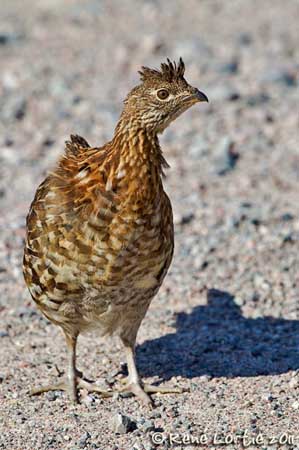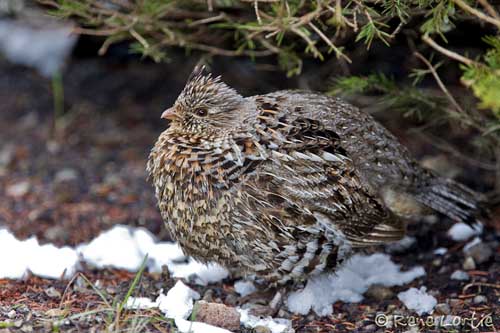
Fr: Gélinotte huppée
All : Kragenhuhn
Esp : Grévol Engolado
Ital : Tetraone dal collare
Nd: Kraaghoen
Sd: Kragjärpe
Photographers:
Jean Michel Fenerole
Photos d’Oiseaux du monde
Paul Guillet
Photos d’Oiseaux
René Lortie :
http://rlortie.ca/
Text by Nicole Bouglouan
Sources:
HANDBOOK OF THE BIRDS OF THE WORLD Vol 2 by Josep del Hoyo-Andrew Elliot-Jordi Sargatal - Lynx Edicions - ISBN: 8487334156
FIELD GUIDE TO THE BIRDS OF NORTH AMERICA - National Geographic Society - ISBN: 0792274512
Hennache, A. & Ottaviani, M. (2005). Monographie des faisans, volume 1. Edition W.P.A. France, Clères, France. ISBN: 2-9512467-1-4
Hennache, A. & Ottaviani, M. (2006). Monographie des faisans, volume 2. Edition W.P.A. France, Clères, France.ISBN: 2-9512467-2-2
Les auteurs renoncent à leurs droits d'auteurs pour que la vente de cet ouvrage, publié par la World Pheasant Association, soit destinée à soutenir des projets de conservation.
BirdLife International (BirdLife International)
About.com – Birding / Wild Birds
Bird Web (Seattle Audubon Society)
Birds of Nova Scotia (Robie Tufts)
Wikipedia, the free encyclopaedia
Ruffed Grouse
Bonasa umbellus
Galliforme Order – Tetraonidae Family
BIOMETRICS:
Length: 43-48 cm
Weight: M: 600-650 g – F: 500-590 g
DESCRIPTION:
The Ruffed Grouse is the state bird of Pennsylvania.
This medium-sized grouse is usually found in woodlands, but it is very shy and difficult to see.
This grouse is fairly large, with the typical cryptic plumage of the mainly terrestrial species.
The Ruffed Grouse has short crest and fan-shaped multiband tail with conspicuous black subterminal band in male. It shows an erectile black ruff on neck sides. It has small orange-red combs above the eyes, more visible in spring. Lores and short stripe behind the eyes are white.
The bill is brownish-black. The eyes are brown. The strong legs and feet are greyish.
The female is fairly similar but she lacks the combs. Her tail is shorter and the dark subterminal band is incomplete. She has less white spotted rump than male. The ruff is absent.
The juvenile resembles adult female but it lacks the dark subterminal band of the tail, and it has mottled primaries.
This species occurs in two morphs, grey and red, mainly visible in tail colours. The red morph is more often visible in the humid Pacific Northwest and the Appalachian region, whereas the grey morph is commoner in N and W, outside the previous Pacific area.
Fourteen species are recognized according to the range.

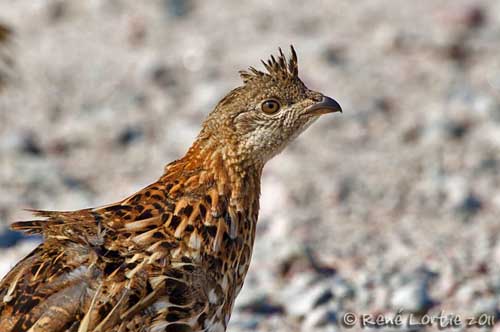
VOICE: SOUNDS BY XENO-CANTO
During the displays, the Ruffed Grouse male produces a hollow, accelerating, drumming noise, by beating the wings in order to attract females. This is a flurry of rapid and strong strokes of the wings while the bird is perched. The wings can be beaten 50 times in only 5-8 seconds, and they are simply beaten against the air.
Usually, females have wider repertoire than males, with greatest variety of calls, often related to breeding, nesting and defence behaviours.
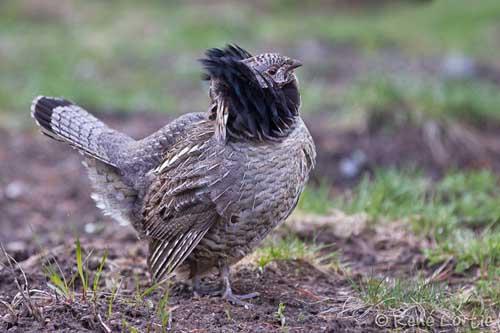
HABITAT:
The Ruffed Grouse frequents several types of woodlands, from boreal forest to Pacific coast rainforest, and dry deciduous and mixed woodlands.
This species needs brushy areas and dense sapling aspen stands to provide cover and protection to the brood.
RANGE:
The Ruffed Grouse is resident in its wide range, from W Alaska, across Canada to Appalachian Mountains.
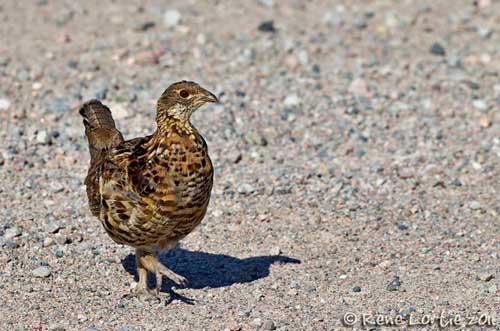
BEHAVIOUR:
The Ruffed Grouse’s diet varies according to the season. During winter, when the snow cover is continuous, it feeds on buds and twigs of trees, according to food availability. After winter, they feed on leaves and flowers on the ground. In summer, they take berries and fruits from several plant species.
During the nesting period, chicks are fed with arthropods during the first two weeks. Then, in autumn, fruits, leaves, acorns, mushrooms, buds and catkins are taken.
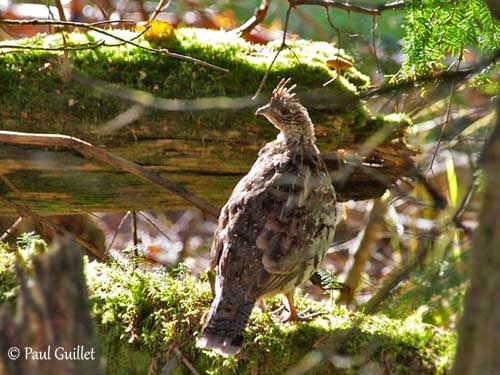
During the breeding season, the male performs courtship displays to attract females. The main display used too in territorial defence is the drumming. It performs strong, rapid strokes of the wings while it stands on a log, often at the same place.
The bird clings firmly onto the log with the claws while beating strongly its wings. The sound is produced by air compression. The tail is widely fanned against the perch to keep the balance during these rapid movements.
This display usually takes place at dawn, in safe place with high density of trees.
The Ruffed Grouse male may copulate with several females, and it maintains large territories usually scattered throughout the forest.
On the other hand, the female builds the nest without paying any attention to the territorial distribution of males. The cryptic plumage is a good protection and provides her the perfect camouflage when she is incubating on the ground.
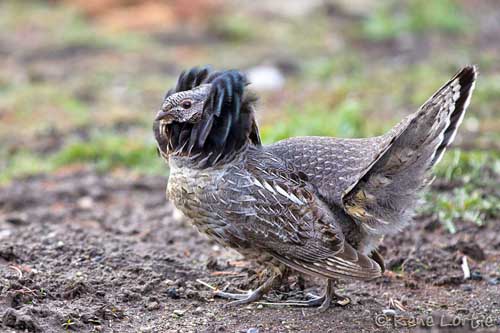
FLIGHT:
The Ruffed Grouses are mainly terrestrial, but when disturbed, the flushed birds burst into flight with rapid wingbeats producing an audible roar.
REPRODUCTION:
The laying occurs mostly in late May – early June. The female builds the nest on the ground, on the forest floor. It is a bowl made with leaves and without lining. For better protection, it is often placed at base of tree, stumps or large log, but however in fairly open situation.
She lays 6-15 whitish eggs and incubates during 23-24 days. The chicks hatch at the same time. They are able to follow their mother after a few hours. She leads them away from the nest-site, towards a stand of trees, often aspens, for food and cover protection.
Chicks are precocial and able to fly 10-12 days after hatching. They are sexually mature at one year old.

If the brood is threatened by a predator, the female performs distraction display, often the “broken-wing” display, to lead the predator away from her chicks. Each brood has its own territory where it can feed and find protection.
DIET:
The Ruffed Grouse is omnivorous, feeding on wide variety of plant matter according to the season. Chicks are fed with arthropods during the first 10-15 days, such as ants, flies and beetles, but also spiders, grasshoppers and caterpillars.
Outside this period, they feed on buds, flowers, leaves, twigs, berries and fruits from various plant species.
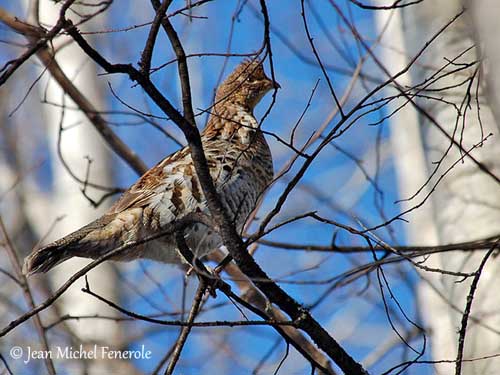
PROTECTION / THREATS / STATUS:
The Ruffed Grouse is an important game bird in most parts of the range. This species is also vulnerable to fragmentation of mature forests for human developments.
Thanks to its wide range, the species is not currently threatened.
